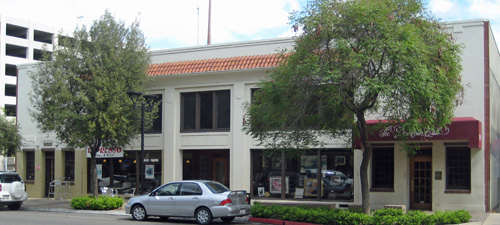
Fresno Republican Printery (1919)
2130 Kern Street
Edward Glass & Charles Butner, Architects
Mediterranean
Revival
Description
Located on Kern Street between L and Van Ness Streets in downtown Fresno, the Fresno Republican Printery building was designed by architects Edward Glass and Charles Butner to accommodate the job printing division of the Fresno Morning Republican newspaper. The building was essentially a large warehouse space, with six banks of northern exposure skylights to naturally illuminate over 8500 square feet of print shop. Structurally, the building was designed with two-story-high exposed brick walls on the east and west sides, as well as at the rear. A series of twelve exposed trusses spanned the print shop in pairs, which rested on six centrally-aligned posts. A small reinforced concrete basement at the rear of the building housed a boiler room, a small foundry, and two above-level lavatories. The 80' by 140' building was fronted by an office complex that, although only 25' deep, represented almost 3400 square feet of usable space, including a beautifully-conceived mezzanine work area. A 3000-square-foot storage basement was located beneath the formal offices, and was accessible both by stairwell and freight elevator.
From its sidewalk frontage on Kern Street, the Printery presents an elegantly symmetrical and carefully proportioned commercial facade of plastered brick, simple exposed-brick window sills and headers, painted window sash and door casements, repetitive diamond-shaped decorative tiles, and a long shallow canopy eave of red Spanish roofing tile that provides a wet weather shelter for the mezzanine windows. The central entrance survives with only one of an original pair of natural oak French doors. Flanking the formal entry doors and bilaterally-positioned showcase windows are two small office entrances with individual French doors, and double-hung sash windows to each side. Banner-sized Roman lettering over both the main office entrance and the street-level showcase windows indicates the building by name and craft.
Although the building's soft sandstone exterior color contrasts informally with the auburn tones of roofing tiles and bricked window details (a condition that suggests indebtedness to California's Mediterranean Revival tradition), the Printery's formally delineated elevation suggests Charles Butner's application of the classical visual vocabulary generally associated with the eastern academic and professional education that he had enjoyed. The office interior is detailed in solid oak, with a dramatic staircase leading to the mezzanine work area. The oak paneling, counters and floor remain entirely intact, and have taken on that subtle patina that only time can grant.
Historical significance
The Fresno Republican Printery building was originally planned when the job printing division of the Fresno Morning Republican newspaper outgrew its space in the publishing headquarters at Van Ness Avenue and Tulare Street in downtown Fresno. Published from 1876 until 1932, the Republican was a major force in the social, cultural, and publishing history of early California. In order to accommodate the expanding commercial printing business, an annex went into construction at the Kern Street address in late 1919. A significant amount of original press equipment, historical type, and print shop furniture that had been used by the newspaper since 1876 was relocated to the new building in early 1920.
Only a few years later, the Fresno Morning Republican was sold, and control of the printery was assumed by William Glass, former Republican business manager and father of architect Edward Glass. When Glass was appointed Commissioner of Finance for the City of Fresno in 1925, he relinquished control of the Printery to his son-in-law, Leon Camy, whose forebears had settled in the San Joaquin Valley as sheepherders in the early 1860s and became proprietors of Camy's French Hotel in Fresno in 1874. Leon Camy continued operating the commercial printing business well into the 1970s, when advanced technology finally caught up with the company, and the Republican Printery ceased to function as a major printing house in the San Joaquin Valley.
In 1982 the Fresno Republican Printery was converted into
a private dining facility known as the Downtown Club. This five-year certified
historic rehabilitation preserved the dramatic sawtooth skylight roof and
incorporated a major nineteenth-century newspaper press in its design of the
dining
 hall.
A lounge separate from the dining area utilizes a historic back bar built in
the late 1880s in San Francisco for
hall.
A lounge separate from the dining area utilizes a historic back bar built in
the late 1880s in San Francisco for
 the Sing Chong Lung Kan Kee
Company. The company utilized the carved back bar surmounted by a bust of
Bacchus in a Fresno Chinatown gaming establishment.
the Sing Chong Lung Kan Kee
Company. The company utilized the carved back bar surmounted by a bust of
Bacchus in a Fresno Chinatown gaming establishment.
Adapted from the National Register of Historic Places nomination, originally prepared by John Edward Powell.
Photos of Downtown Club ©1982 H. S. Barsam, Architectural Photography, Fresno CA. Courtesy of Lew & Patnaude Architects.